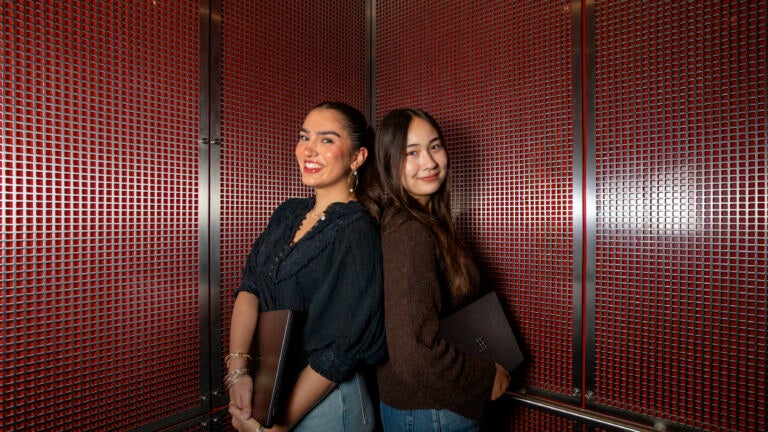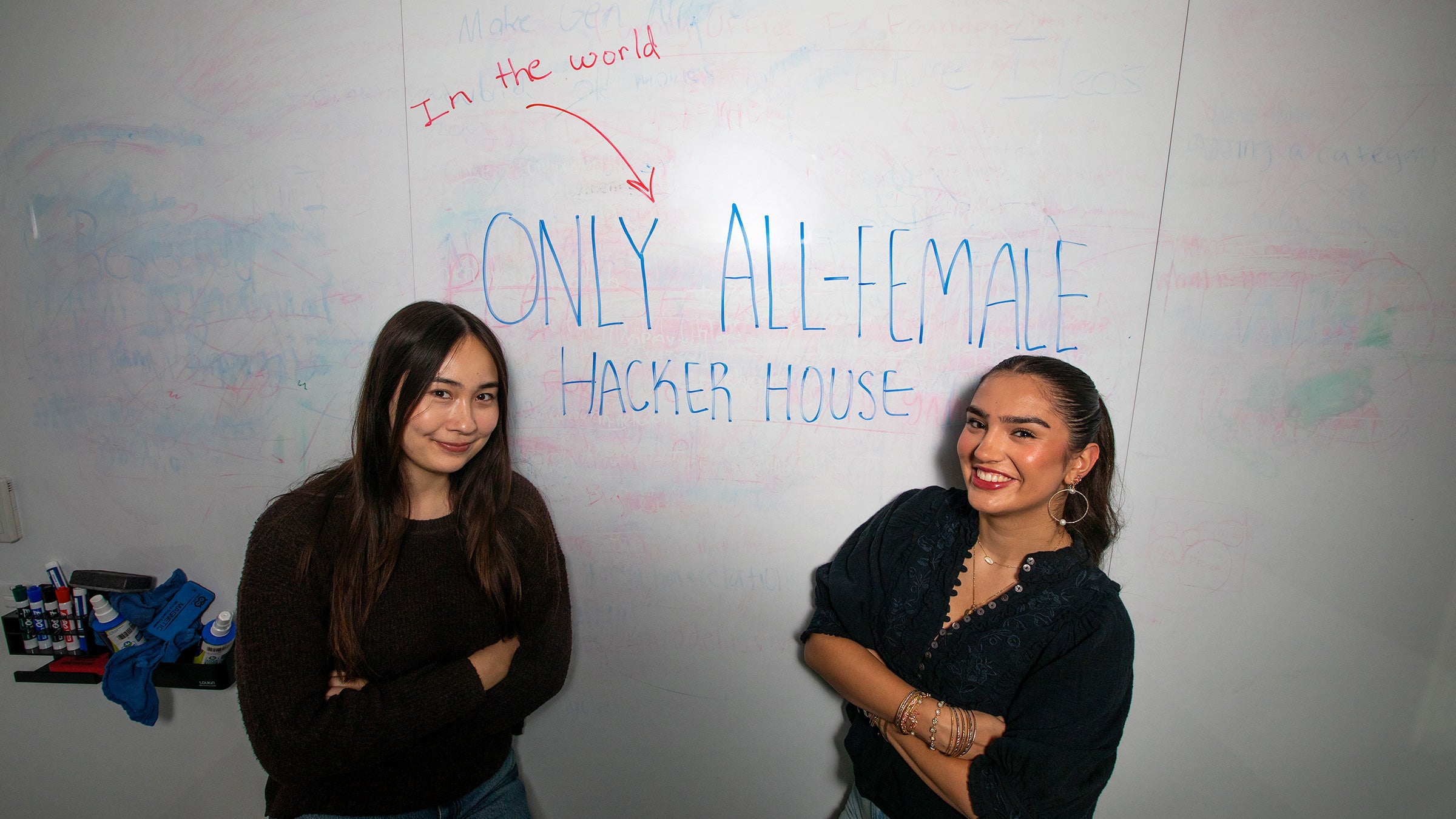
FoundHer House creators Anantika Mannby (left) and Miki Safronov-Yamamoto are creating a physical and online ecosystem to support female founders of tech startups. (USC Photo/Brian van der Brug)
In the AI Boom, a Room of Their Own
FoundHer House, an all-female hacker house started by two students at the USC Iovine and Young Academy, aims to accelerate the growth of female-led, AI-driven tech startups.
Early this year, Anantika Mannby and Miki Safronov-Yamamoto — then first-year students at the USC Jimmy Iovine and Andre Young Academy — set their sights on spending the summer in San Francisco to grow their budding tech startups. Like many young entrepreneurs, the two friends and classmates were drawn to the AI boom unfolding in the city, home to influential artificial intelligence companies like OpenAI and Anthropic, as well as major venture capital firms.
Mannby wanted to grow Treffa, the social shopping platform she founded in 2023 during the two gap years she took between high school and USC. Safronov-Yamamoto wanted to develop Veyra, an AI-powered system that detects and disputes medical billing errors — a company she conceived during her first semester at USC.
They were looking to rent rooms in one of San Francisco’s many hacker houses, collaborative live-work spaces where startup founders find camaraderie, networking opportunities and resources to incubate their ventures.
“We realized quickly that a lot of these hacker houses were very male-dominated,” Safronov-Yamamoto says. “It was difficult for us to even find a place where there would be any women in the house. And if there were women, it’d be a really terrible ratio — like one or two in a house of 10.”
That discovery sparked an idea. “We figured if there aren’t many spaces for women, we might as well create them,” Mannby says.
In May, the pair established FoundHer House, a rare all-female hacker house, in San Francisco’s Glen Park neighborhood. From about 100 applicants, they selected six other female startup founders from across the country to join them in a furnished, four-bedroom Airbnb for a summer of building and bonding. Collectively, the women made quite a splash in the city — turning heads at industry events, raising millions of dollars in venture capital, and garnering headlines in The New York Times, USA Today and other major media outlets.
Now back at USC for their sophomore year, Mannby and Safronov-Yamamoto are balancing coursework and work on their respective companies with expanding the FoundHer House brand.
“USC is fundamentally such a creative school and values the pre-professional careers that we’re building,” Mannby says. She and Safronov-Yamamoto credit USC professors, mentors and funding opportunities with providing structure and support for launching FoundHer House and sustaining the summer momentum.
“FoundHer House is a perfect example of the imaginative, entrepreneurial, socially impactful spirit that USC Iovine and Young stands for, and it’s also a perfect testament to the kind of infrastructures of support around innovation and collaboration that USC provides to our students,” says Josh Kun, interim dean of USC Iovine and Young Academy, vice provost for the arts, and professor and chair in cross-cultural communication at the USC Annenberg School for Communication and Journalism. “Miki and Anantika did what our students are trained to do. They looked out at the world, saw a problem and figured out how to fix it with their own energy, ideas and vision. It’s their own version of ‘world building’: creating something that didn’t previously exist in order to generate new social and economic possibilities.”
Finding their niche in the AI boom
Mannby and Safronov-Yamamoto are both from Seattle but didn’t meet until they were admitted to USC. Their friendship grew organically from shared coursework, activities and interests in robotics, art and entrepreneurship.
In high school, Safronov-Yamamoto ran a college guidance business with a friend. But until she began classes at USC Iovine and Young Academy, she hadn’t considered a path in the AI startup boom. “I didn’t even know what AI was until I got here,” she says.
Last fall, the “Disruptive Innovation” class she and Mannby took — co-taught by Chris Swain, an associate professor, and Michael Kanazawa, a distinguished visiting lecturer — was a turning point. Safronov-Yamamoto learned how AI tools were driving new business concepts and capabilities across industries. The class kindled her interest in building an AI tool of her own. “I wanted to create impact at scale, and that’s what really drew me to startups,” she says.
Mannby, who conceived the idea for Treffa in high school, had prior experience working with LLMs (large language models) and machine learning before starting at USC. But she notes that Swain and Kanazawa’s class accelerated her knowledge of AI and how to incorporate it into Treffa’s digital platform. “During that first semester, Treffa grew from having no users to tens of thousands of users,” she says.
Last fall, both women joined USC’s entrepreneurship society SEP, an accelerator for business ideas. They also began participating in aspects of USC Iovine and Young Academy’s Innovation Quest, a yearlong set of extracurricular experiences designed to accelerate, cultivate and support student-led ventures. The Innovation Quest — directed by USC Iovine and Young Academy Lecturer Tina Sharkey and currently co-led by Swain and Thomas Dadourian, an adjunct lecturer — complements the academy’s cutting-edge curriculum that fuses creativity, technology and innovation. In December 2024, as part of the Innovation Quest, Mannby won a $3,000 Gen AI and Society Ignite Grant award to help grow Treffa.
Collectively, experiences in SEP and USC Iovine and Young Academy helped fuel their San Francisco aspirations. But as they researched hacker houses, they felt concerned about living in a house where they were the only women among a group of men. They spoke with other female founders who shared their discomfort and realized their mission for the summer was much larger than just enlarging their startups’ coffers and customer bases.
“We wanted to create a space female founders could feel safe in, where they could feel supported alongside other women working toward the same goals,” Safronov-Yamamoto says.
Hacking a solution

The pair turned to Sharkey for guidance in realizing their vision. Sharkey has three decades of experience as a founder, operator and investor and is also the principal investigator for the Generative AI & Society Grant, a Verizon-funded initiative administered through the USC Office of Research and Innovation that supports cross-disciplinary, student-driven innovation at the intersection of generative AI and society. She has a broad perspective of the headwinds facing young female founders in the male-dominated tech industry.
Despite decades of progress, “there is still a structural imbalance in venture capital networks,” Sharkey says. “The majority of investors are male, and many funding decisions are shaped by pattern recognition and prior relationships. Women often face additional barriers to being perceived as ‘venture backable,’ especially when they are early in their careers or building in new sectors.”
She notes that a 2024 report by PitchBook, which tracks the industry, found that only about 2% of U.S. venture-capital funding went to startups with all-female founding teams. Female-only AI startups receive less than 3% of total AI-focused venture funding, Sharkey says, citing data from PitchBook, Crunchbase and All Raise.
“That’s not because there isn’t female talent,” Safronov-Yamamoto says. “It’s about getting female talent into those rooms.”
Another purpose for FoundHer House crystallized: The house would not only be a safe, supportive living space, but it would also establish a network to connect women founders to venture capital and other critical industry resources, thereby bolstering the pipeline of female-led companies in the AI boom.
“AI is driving the innovation of everything we’ll see in the future,” Mannby says. “I think it’s incredibly important to have more women in that space, more representation … or we’re creating a world without women in mind.”
Sharkey immediately recognized the merit of the pair’s pursuit. She introduced them to her network of founders and investors and coached them through how to approach venture capitalists and do outreach. During spring semester, “we were talking to VCs almost every other day trying to get funding,” Mannby says. “There was definitely a learning curve — a lot of ‘no’s.”
Capital and confidence
As they pursued funding for FoundHer House, Mannby and Safronov-Yamamoto notched some impressive wins for their companies. In April, they participated in USC Iovine and Young Academy’s Venture Showcase, the culminating event of Innovation Quest. The event is a Shark Tank-style competition in which industry leaders and investors reward monetary prizes to the most promising student-led companies.
Mannby’s Treffa team took home the $25,000 Prize, which focused on ventures utilizing or developing GenAI technologies. Safronov-Yamamoto’s Veyra team won the $10,000 IYA Social Impact Prize, which celebrates ventures making a meaningful and positive societal impact. In May, both women also received the Student Empowerment Entrepreneurship Prize, a $15,000 award from the USC Office of Research and Innovation, to advance their companies. The prizes were a strong vote of confidence — and an infusion of capital — for their ambitions in San Francisco.
Swain wasn’t surprised by their wins. He notes that Mannby and Safronov-Yamamoto possess a rare combination of elements that have catapulted many fledgling startups to success: They tap into the zeitgeist, demonstrate customer traction and shine as leaders. “Both of them have what I would call an unstoppable personality,” he says. “They have that magnetism.”
Around the same time, funding came through for FoundHer House. Sharkey’s colleague, Brad Feld — a partner at Foundry, a venture capital fund, and co-founder of Techstars, a startup accelerator — offered $10,000, the first and largest of several investments for the hacker house. Additionally, Mannby and Safronov-Yamamoto were each awarded $1,000 from the USC Iovine and Young Academy Student Opportunity Fund for FoundHer House.
The funds helped subsidize the $40,000 cost of renting the San Francisco home for the summer, allowing each of the eight women to pay only $1,100 to $1,300 per month (a bargain in a city where the average one-bedroom apartment rents for approximately $3,100 per month).
Mannby and Safronov-Yamamoto established FoundHer House as a nonprofit. “We were raising the funding just so we could make it an accessible opportunity for others,” Safronov-Yamamoto says.
Forging a tight-knit community
The duo had no trouble attracting interested residents. About 100 women responded to the call for applications that was posted on the FoundHer House website and its Instagram and LinkedIn accounts. Even after applications closed, more than 100 women contacted them expressing their desire to join.
“We were looking for people who were kind and supportive and also were serious about building a startup — the brightest, most talented, most high-agency, ambitious female founders who were really ready to go all-in,” Safronov-Yamamoto says.
“We were able to find the best of the best female founders,” Mannby says of the group they assembled. “I guess not even just the best female founders — the best founders. They just happen to be female.”
The women’s companies, all of which integrate AI into their solutions, spanned industries ranging from health care to clean energy, financial technology, education and e-commerce. By day, the residents worked independently. But in the evenings, they gathered for lively conversations at the communal dinner table and hosted dinners and meetups, including an all-female venture capital event.
“It became a mini-ecosystem that attracted founders, investors and technologists into their orbit, not just a house where people coded,” Sharkey says.
Mannby felt energized and inspired by the bustle of activity. “It gives you so much confidence to go out and do things in this world,” she says. “A girl in the house is raising a couple million dollars today, and someone else is flying to New York for meetings tomorrow, and someone else is taking meetings with huge companies … it makes you feel like you can go, step out and take up that space.”
As a group, the women often attended industry parties and events to network, finding power in numbers to ease their comfort in these male-dominated contexts. “Together, we were this force who showed up,” Mannby says. “You could feel the change we created in every room we walked into very palpably.”
Throughout the summer, Mannby and Safronov-Yamamoto were very intentional about documenting the goings-on at FoundHer House on social media. “We wanted to change the narrative of what it meant to be a female founder in tech,” Safronov-Yamamoto says. “You might see a lot of men on your social media [feeds] building startups. There are women out there who are building stuff, and I think the more that we can get that out there, the more we can inspire young women to take that leap and go and follow their dreams.”
Fruits of their labor
By mid-August, the women had plenty to show for their intensive summer efforts. A FoundHer House “demo day” that they planned to showcase their startups attracted 200 of the industry’s top investors, founders and operators. Mannby says that her peers who secured funding collectively raised over $6.5 million in investments during the summer and after demo day.
Major news outlets picked up the FoundHer House story, affirming Mannby and Safronov-Yamamoto’s efforts to promote their narrative. In October, one of the FoundHer House residents was featured in an Apple ad seated at the house’s dinner table, around which they’d forged lifelong friendships.
“Obviously, I’m happy we have press and attention and money and all that, but those friendships would have made the whole thing worth it in and of itself,” Mannby says.
Both Mannby’s and Safronov-Yamamoto’s companies attracted significant VC interest and thrived during the summer. Veyra hired two interns, made revenue and saved users $15,000 on medical bills. Treffa reached over half a billion views on social media and expanded its market saturation from teenage girls shopping for dresses to many e-commerce domains.
“FoundHer House did an incredible job at helping me meet the right people — people I could potentially work with for the next decade or so,” Safronov-Yamamoto says. “I don’t think I would have been able to get into those [VC] rooms and meet those people without it.”
The next chapt-her
When FoundHer House disbanded following demo day, two of the house’s residents decided to drop out of college to focus on their companies full-time. But Mannby and Safronov-Yamamoto knew they wanted to return to USC to finish their degrees.
“One of the reasons I’m staying at USC is definitely for the community, definitely for the network, and also for the resources that the Iovine and Young Academy provides,” Safronov-Yamamoto says. “There’s still a lot more I can take out of the program.”
“I now have nearly 100,000 users that I have to maintain every day and grow every day,” Mannby says of Treffa. “It’s very unique to be able to do that, and be in school, and also build FoundHer House. I can’t imagine another school that really provides resources in that way.”
“I think my favorite thing about USC is that when you walk around campus, people don’t say, ‘I’m off to class’; they tell you what they’re building and what they’re creating,” she adds. “The emphasis on this extracurricular pursuit of creativity and creating things from scratch, I think, is really, really powerful — and unlike any other school anywhere.”
Next summer, the pair plan to expand FoundHer House to two houses, one in San Francisco and one in New York, where Mannby will spend her summer. They also envision a house in Los Angeles in years to come. In addition to the physical houses, they’re nurturing an online ecosystem to support female founders wherever they are.
As they continue to fundraise and hire administrative teams to help them run the houses, they aim to expand FoundHer House programming to include hackathons, conferences and other tech events. They’re dreaming big with storytelling: “movies or books or anything we can put out to continue to share this narrative with the world and what women are building,” Mannby says.
“There’s no limiting mindset at all when we work together,” Safronov-Yamamoto says.
“We’re friends first and co-founders second, and we’ll continue to create incredible things,” Mannby says. “I’m really excited that USC brought us together.”



